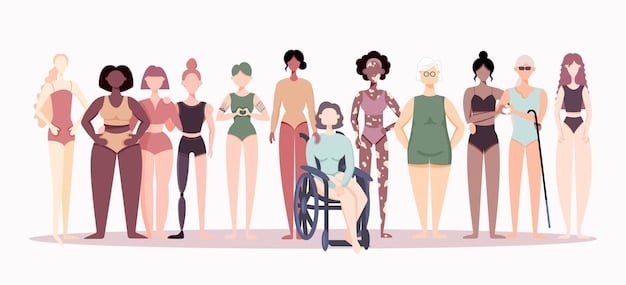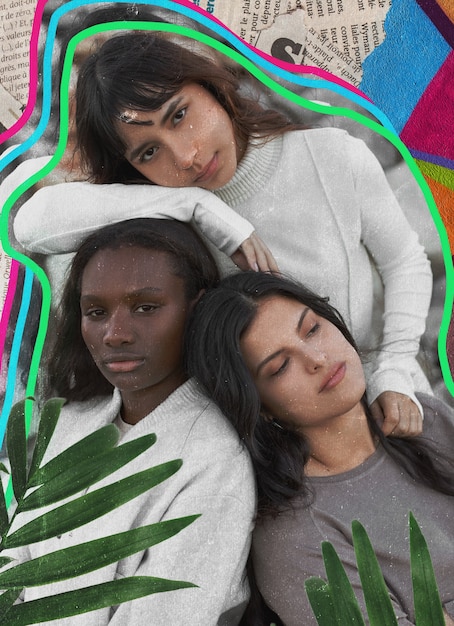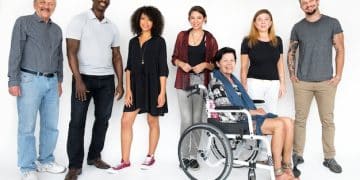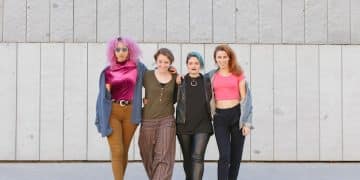Redefine Beauty Standards: Social Media Activism’s Impact

Advertisements
Redefining beauty standards is increasingly influenced by social media activism, which challenges traditional norms and promotes inclusivity, diversity, and body positivity in media representation and societal perceptions.
Advertisements
The rise of social media activism is reshaping how we perceive beauty, challenging long-standing ideals and promoting a more inclusive and diverse representation. Redefine Beauty Standards: How Social Media Activism is Changing Perceptions have become powerful forces in celebrating individuality and body positivity.
The Evolution of Beauty Standards
Advertisements
Historically, beauty standards have been narrowly defined, predominantly influenced by media portrayals and societal expectations. These standards often favored a specific look, leaving many feeling excluded and marginalized. However, this began to shift as people started questioning these restrictive norms.
The emergence of the internet and social media platforms provided a space for alternative voices to challenge these established beauty ideals. Individuals began sharing their stories, showcasing diverse representations, and demanding a more inclusive definition of beauty.

Influences on Traditional Beauty Standards
Traditional beauty standards have been largely shaped by the fashion and entertainment industries. These industries often promote a specific, often unattainable, image of beauty through magazines, movies, and advertisements.
- Media Representation: Limited representation of diverse body types and ethnicities in mainstream media.
- Advertising Influence: Beauty product advertisements often perpetuate unrealistic ideals.
- Fashion Industry: The dominance of a specific body type on runways and in campaigns.
These influences have historically created a self-perpetuating cycle, reinforcing narrow beauty ideals and leaving many individuals feeling inadequate.
Social Media’s Role in Challenging Norms
Social media has become a catalyst for challenging traditional beauty norms, enabling individuals to create and share their own narratives. This shift has opened up conversations around inclusivity, body positivity, and self-acceptance.
Platforms like Instagram, TikTok, and Twitter have allowed ordinary people to become influencers, sharing their unique perspectives and promoting alternative beauty standards that celebrate diversity and individuality.
User-Generated Content
User-generated content (UGC) has played a pivotal role in redefining beauty standards. Individuals are using social media to share their unfiltered, authentic selves, challenging the polished and often unrealistic images promoted by mainstream media.
- Authenticity: Sharing unedited photos and videos to showcase real bodies and skin textures.
- Diverse Representation: Showcasing diverse ethnicities, body types, and abilities.
- Personal Narratives: Sharing personal stories of self-acceptance and body positivity.
This authenticity and diversity resonate with audiences, fostering a sense of community and empowerment.
Activism and Hashtag Movements
Activism on social media has led to powerful movements that challenge traditional beauty standards and promote inclusivity. Hashtags have become tools for individuals to connect, share their stories, and demand change.
These movements often focus on issues such as body shaming, fatphobia, and the lack of representation of marginalized groups in mainstream media. By creating awareness and sparking conversations, they are driving significant cultural shifts.
Notable Hashtag Movements
Several hashtag movements have gained significant traction, challenging traditional beauty standards and promoting body positivity.
- #BodyPositivity: A movement to promote acceptance and appreciation of all body types.
- #EffYourBeautyStandards: A hashtag celebrating beauty outside of conventional norms.
- #Unfiltered: A trend encouraging people to share unedited photos and videos to promote authenticity.
These hashtags have created supportive online communities where individuals can share their experiences and find encouragement.
The Impact on Media Representation
The efforts of social media activists have started to influence media representation, leading to more diverse and inclusive portrayals of beauty. Brands and media outlets are beginning to recognize the importance of reflecting the diversity of their audiences.
This shift is evident in advertising campaigns, magazine covers, and television shows, which are increasingly featuring individuals who represent a wider range of ethnicities, body types, and abilities.

Changes in Advertising and Fashion
The advertising and fashion industries are starting to incorporate more inclusive practices, influenced by the demands of social media activists and consumers.
Brands are featuring models with diverse body types and ethnicities in their campaigns, showcasing realistic representations of beauty. This shift is not only more inclusive but also resonates with consumers who are seeking authenticity and relatability.
These changes reflect a growing recognition that beauty is not one-dimensional and that representation matters.
Challenges and Criticisms
While social media activism has made significant strides in redefining beauty standards, it is not without its challenges and criticisms. Issues such as performative activism, the commercialization of body positivity, and the persistence of unrealistic ideals still need to be addressed.
It’s important to critically examine the impact of these movements and work towards genuine, sustainable change.
Potential Pitfalls
Several potential pitfalls can undermine the effectiveness of social media activism in redefining beauty standards.
- Commercialization: Brands co-opting the body positivity movement to sell products without genuine commitment.
- Performative Activism: Individuals engaging in activism for social validation rather than genuine concern.
- Unrealistic Expectations: The pressure to constantly present a positive image, even when struggling with self-acceptance.
Addressing these pitfalls requires ongoing dialogue and critical self-reflection.
Future Trends in Beauty Standards
Looking ahead, several trends are likely to shape the future of beauty standards. These include the continued emphasis on authenticity, the rise of personalized beauty, and the integration of technology into self-care practices.
The focus will likely shift towards celebrating individuality and empowering individuals to define beauty on their own terms.
Emerging Technologies
Emerging technologies are poised to play a significant role in shaping beauty standards and self-care practices.
- AI-Driven Personalization: Tailoring beauty products and routines to individual needs and preferences.
- Virtual Reality (VR) and Augmented Reality (AR): Providing immersive experiences for self-discovery and exploration.
- Digital Health Tools: Tracking and monitoring physical and mental well-being to promote holistic self-care.
These technologies have the potential to empower individuals to take control of their beauty journeys and redefine standards on their own terms.
In conclusion, social media activism has significantly influenced how beauty standards are now portrayed and accepted. By amplifying diverse voices and challenging unrealistic expectations, these movemenets are changing perceptions and are fostering inclusivity. This progress signals a shift towards a broader, more accepting perception of what is beautiful.
| Key Concept | Brief Description |
|---|---|
| 💪 Body Positivity | Acceptance of all body types, challenging unrealistic norms. |
| 📱 Social Media Activism | Using platforms to promote inclusivity and challenge standards. |
| 🌟 Diverse Representation | Featuring various ethnicities, body types, and abilities in media. |
| #️⃣ Hashtag Movements | Using hashtags to connect and share stories of self-acceptance. |
FAQ
Social media has broadened beauty standards by providing platforms for diverse representation and challenging traditional media’s narrow ideals. This has led to more inclusive and realistic portrayals.
Body positivity is a movement that promotes the acceptance and appreciation of all body types. It encourages individuals to love their bodies as they are, regardless of societal pressures.
Diverse representation ensures that everyone feels seen and valued, regardless of their ethnicity, body type, or ability. It fosters a more inclusive and equitable society for all individuals.
Challenges include commercialization, performative activism, and the persistence of unrealistic beauty ideals. These undermine genuine self-acceptance and need critical examination to be addressed.
You can promote positive beauty standards by supporting diverse media, challenging unrealistic portrayals, and practicing self-acceptance. Sharing your authentic self online is also a good way to promote positive messages.
Conclusion
In conclusion, the movement to redefine beauty standards, driven by social media activism, highlights the power of collective effort in challenging conventional norms. This shift towards inclusivity and diversity transforms not only media representation but also societal perceptions, leading to a more accepting and empowered world for individuals to embrace their unique beauty. The ongoing conversations and movements are essential in fostering genuine self-acceptance and redefining beauty for future generations.





